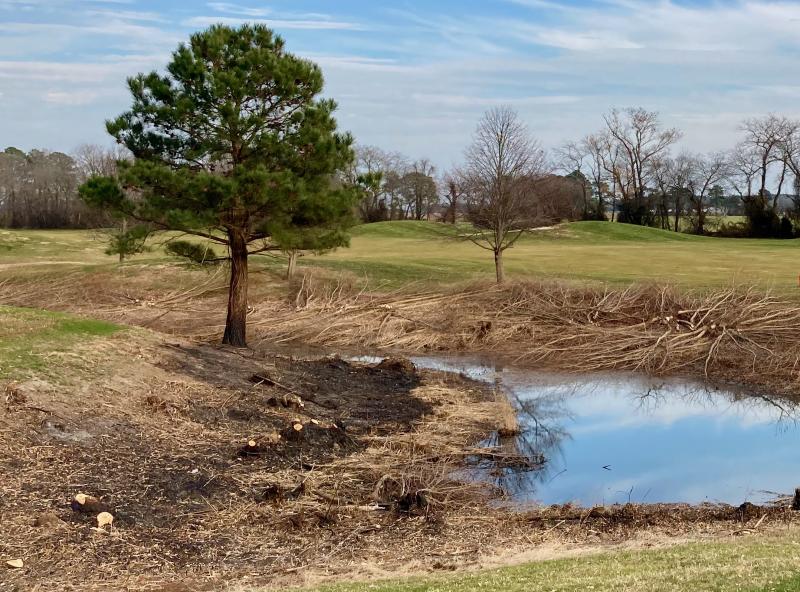Going ‘scorched earth’ can be a good thing
Dozens of trees recently disappeared at the Rookery golf course.
It marks a welcome return to how the popular public layout looked when it opened for play in 2020. It is also good news for the course’s turf grass, which usually loses in any competition with the tall stuff.
Here is what happened.
To create water storage and fill ground for landscaping when the course was built, the Rookery owners dug out several ponds. The pond near the ninth green, at the highest elevation, taps into the aquifer below the property. Underground pipes connect the ponds, with stormwater outfalls near the ponds by the fourth and 12th holes.
The new ponds attracted waterfowl, so owner/designer Chris Adkins planted marshmallows and other plants at the edges to convince geese to go somewhere else.
That worked for a while but didn’t last. Bird-carried seeds led to the growth of trees at the pond edges. Tree roots crept into nearby drainage pipes for the greens and clogged them. Non-native, invasive phragmites also appeared, creating a continuing maintenance headache.
Course superintendent Mike Pyne decided now was the time to go scorched earth on these issues – and I mean that literally.
You can see burned ground where phragmites were once seen in several places, such as the pond edges of the island green 15th hole. In addition, tree stumps are the only remaining sign of dozens of trees formerly found next to the ponds.
Pyne said, “I’m going for getting back to the original design of things, to go for a cleaner look. And to embrace what this golf course really is, and that’s open.
“Our goal, really, is to bring the focal points in, which are our ponds. That’s what we give you visually. And maybe even to trick the eye [by] disguising the edges a little bit, from where it was more defined by the trees. This will be an ongoing process of keeping the phragmites out and keeping down what are weedy trees. Those were not planted. Nothing that I’m taking down was planted,” he said.
Willows and cherries were the two prime tree culprits, according to Pyne. “The goal in the future would be to remove the stumps and to push the [grass] boundary closer and closer to the edge of the pond where we don’t have much of a buffer zone,” he said.
“I’d love to mow all the way down and have grass all the way. I think it’d be a cleaner look for everybody, and everybody would like it.” Pyne said. “We’re going to rent a stump grinder and then we’re going to use our backhoe for some of the willows.”
Phragmites are a major problem, combining resistance to chemical treatments and the ability to crowd out anything else where they can gain a foothold. Pyne decided to go with the controlled burn. “It’s much more feasible to burn than it is to try and clean it up one by one. From a labor standpoint, I think that’s the correct way to do it,” he said. Pyne also noted that the burns made it easier to locate tree stumps for removal.
He said the tree stumps must be removed instead of letting them rot. “Those willows will come back [and] those cherries will come back. Most of the stuff I’m taking down out there, if we don’t get on it now, then in May they’ll be back with a vengeance, and it will be smaller and harder to remove,” Pyne said. In addition, the drainage pipes for the greens will no longer be blocked by root masses.
I asked him about wind effects from the tree removals. “I didn’t take that into account,” Pyne said. “The wind out here is going to make its way, from my experience, no matter what. These trees that I’m taking down around the ponds aren’t going to make the biggest effect on play.”
One now-gone tree on the seventh hole sometimes created challenges for golfers trying to reach the green from about 160 yards out. Pyne intends to replace it. “I do plan on planting another on 7 on the corner there where the dead one was, because I think that it frames the hole. I’m going to go with another large weeping willow,” he said.
Pyne will also plant new trees between the second-hole tee box and the first-hole green, to protect against shanks. “We’ve had a couple close calls,” he said.
The Rookery looks a bit rough right now in the middle of this project, but that should improve with the coming of spring.
Pyne said, “It’s definitely a beautification project. It’s what I see as my vision for this golf course.”
Later in the interview, he expanded on that comment. “I’m loving the look of it. I’ve heard some mixed reviews from the members, [because] they’re slightly concerned for the wildlife, but I think that in the end the wildlife will prosper. Those herons are going to love me. They’re going to have plenty of room to make their way,” Pyne said.
















.jpeg)









































